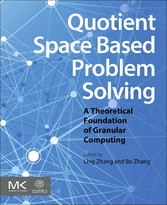Search and Find
Service
More of the content

Quotient Space Based Problem Solving - A Theoretical Foundation of Granular Computing
Front Cover
1
Quotient Space Based Problem Solving: A Theoretical Foundation of Granular Computing
4
Copyright
5
Contents
6
Preface
12
Chapter 1 - Problem Representations
16
1.1 Problem Solving
16
1.2 World Representations at Different Granularities
20
1.3 The Acquisition of Different Grain-Size Worlds
23
1.4 The Relation Among Different Grain Size Worlds
28
1.5 Property-Preserving Ability
36
1.6 Selection and Adjustment of Grain-Sizes
47
Example 1.15
49
1.7 Conclusions
58
Chapter 2 - Hierarchy and Multi-Granular Computing
60
2.1 The Hierarchical Model
60
2.2 The Estimation of Computational Complexity
63
2.3 The Extraction of Information on Coarsely Granular Levels
77
2.4 Fuzzy Equivalence Relation and Hierarchy
92
2.5 The Applications of Quotient Space Theory
103
2.6 Conclusions
117
Chapter 3 - Information Synthesis in Multi-Granular Computing
120
3.1 Introduction
120
3.2 The Mathematical Model of Information Synthesis
121
3.3 The Synthesis of Domains
123
3.4 The Synthesis of Topologic Structures
124
3.5 The Synthesis of Semi-Order Structures
125
3.6 The Synthesis of Attribute Functions
132
Chapter 4 - Reasoning in Multi-Granular Worlds
144
4.1 Reasoning Models
144
4.2 The Relation Between Uncertainty and Granularity
148
4.3 Reasoning (Inference) Networks (1)
150
4.4 Reasoning Networks (2)
162
4.5 Operations and Quotient Structures
175
4.6 Qualitative Reasoning
196
4.7 Fuzzy Reasoning Based on Quotient Space Structures
202
Chapter 5 - Automatic Spatial Planning
208
5.1 Automatic Generation of Assembly Sequences
209
5.2 The Geometrical Methods of Motion Planning
220
5.3 The Topological Model of Motion Planning
222
5.4 Dimension Reduction Method
231
5.5 Applications
245
Chapter 6 - Statistical Heuristic Search
264
6.1 Statistical Heuristic Search
266
6.2 The Computational Complexity
274
6.3 The Discussion of Statistical Heuristic Search
282
6.4 The Comparison between Statistical Heuristic Search and A* Algorithm
295
6.5 SA in Graph Search
309
6.6 Statistical Inference and Hierarchical Structure
311
Chapter 7 - The Expansion of Quotient Space Theory
314
7.1 Quotient Space Theory in System Analysis
314
7.2 Quotient Space Approximation and Second-Generation Wavelets
318
7.3 Fractal Geometry and Quotient Space Analysis
326
7.4 The Expansion of Quotient Space Theory
330
7.5 Conclusions
346
Addenda A - Some Concepts and Properties of Point Set Topology
348
A.1 Relation and Mapping
348
A.2 Topology Space
350
A.3 Separability Axiom
357
A.4 Countability Axiom
359
A.5 Compactness
361
A.6 Connectedness
364
A.7 Order-Relation, Galois Connected and Closure Space
368
Addenda B - Some Concepts and Properties of Integral and Statistical Inference
378
B.1 Some Properties of Integral
378
B.2 Central Limit Theorem
382
B.3 Statistical Inference
384
References
390
Index
396
All prices incl. VAT













